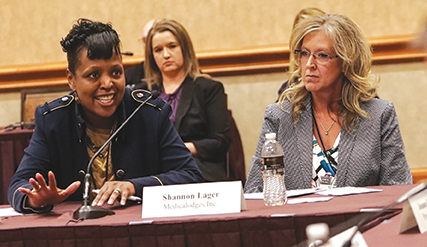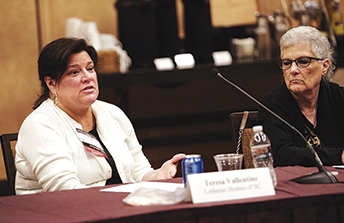Candid conversation ruled the day as long term and post-acute care (LT/PAC) providers and software vendors gathered for the Provider Executive Roundtable sponsored by American HealthTech and moderated by Jerilyn Reinhardt, vice president of quality and performance excellence, Benedictine Health System in St. Paul, Minn., and Joanne Erickson, editor in chief, Provider.

The event, which occurred during the American Health Care Association/National Center for Assisted Living Annual Convention & Expo in Las Vegas in October, saw the 13-member group discuss the challenges and opportunities of validating their resident care in a conversation titled, “Walking the Tightrope: Balancing Good Clinical Outcomes with a Healthy Bottom Line.”
Although much is changing in the payment landscape as the Centers for Medicare & Medicaid Services (CMS) and the marketplace move away from the fee-for-service (FFS) model, providers said the goal remains to achieve high-quality care in a world of Five-Star ratings, preferred provider networks, and competitive specialization.
Mary Ousley, chief strategy officer, PruittHealth, said as the shift from FFS became apparent her company undertook a strategic effort to convene a cross-functional team to address alternative payment models. One result has been to improve data resources and move beyond CMS data to instead have in-depth, timely information PruittHealth contracts for to use in assessing performance. These scorecards give the company essential insight into how referring acute-care hospitals and other stakeholders determine whether to work with the LT/PAC provider.
Reinhardt said while the access to new data flows is apparent, it is not so easy to collate the information into manageable form and have each care center benefit equally from the data.
“I know the computer knows the information, and I get frustrated, and I think probably all of us have had the same struggles that you have five centers that are just doing so well, and then you have five centers that are not. And they all receive the same information,” she said.
Education Takes on Importance
Other ways in which closer attention to data on clinical outcomes is changing the way LT/PAC providers operate is seen in new steps on educating potential referral sources, said Teresa Vallentine, vice president, clinical operations and quality, Lutheran Homes of South Carolina.
Her group is informing prospective residents and their families on how LT/PAC providers are working to limit rehospitalizations, one of the fundamental clinical outcomes that determines reimbursement in a pay-for-value model. Lutheran does this by reaching out to patients early on while potential clients are in the hospital to highlight Lutheran’s emphasis on quality.
“We bring up rehospitalizations at the time of referrals. It seems to have helped us,” she said.

Sandra Kingsley, director of quality assurance and performance improvement at Wilmac Corp. in Arizona, said her company sees relationship building as more important than ever when it comes to gaining referrals and cementing potential preferred provider status with hospitals.
“We are really focused on building those relationships with the home health agencies and the hospitals and the doctor’s offices so that when somebody goes home they know” who is making the call on care management and potential rehospitalizations, she said.
Push to Make Data Useful
How to use information, in the form of education or in the form of data provided from electronic health records (EHRs) acted as a common theme during the roundtable. Providers said they want more access points for the data and easier handling software and tools for clinical staff to use.
Jim Riemenschneider, co-founder and chief revenue officer of quality improvement firm COMS Interactive, said as a technology provider his company is working hard to make products and services more user-friendly.
“That is a key piece of how we need to support providers, which is to take standardized protocols and operationalize them within the [electronic health record] in order to make it easy for the nurses to use,” he said.
The other key aspect of having accurate, useful data streams is to be able to track costs related to the care being provided, the LT/PAC operators said. While hospitals seem to be able to track even the most minute of their costs, the nursing care center is catching up in its ability to do the same, participants said.
“I know there’s a lot going on, and we have all the reimbursement challenges. But, the one thing that I can say about the skilled nursing facility business is that we always survive. It doesn’t matter. We always reinvent ourselves,” said Angela Smith, senior director of reimbursement and rehabilitation for Cantex Continuing Care Network in Texas.